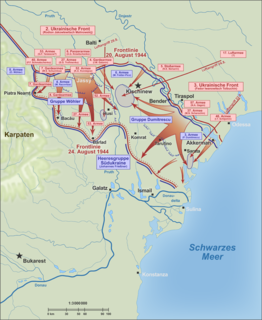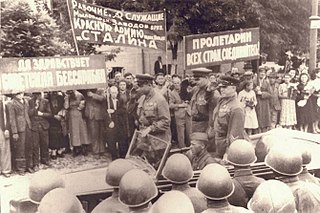List
| Location | Image |
|---|---|
| Adjud |  |
| Alba Iulia |  |
| Buzău |  |
| Câmpulung |  |
| Constanța |   |
| Fălticeni |  |
| Focșani |  |
| Medgidia |  |
| Miercurea Ciuc |  |
| Pașcani |  |
| Roman |  |
| Sighetu Marmației |  |
| Suceava |  |
| Timișoara |  |
| Vlădeni, Brașov |  |
Soviet War Memorials in Romania commemorate the role of the Soviet Union in World War II.
Following the war, hundreds of such memorials were built and inscribed in honor of the “Soviet heroes” who “liberated” Romania from the “fascist yoke”. They are protected by a 2003 law guaranteeing the integrity of graves and war memorials. [1]
| Location | Image |
|---|---|
| Adjud |  |
| Alba Iulia |  |
| Buzău |  |
| Câmpulung |  |
| Constanța |   |
| Fălticeni |  |
| Focșani |  |
| Medgidia |  |
| Miercurea Ciuc |  |
| Pașcani |  |
| Roman |  |
| Sighetu Marmației |  |
| Suceava |  |
| Timișoara |  |
| Vlădeni, Brașov |  |

The Warsaw Pact (WP) or Treaty of Warsaw, formally the Treaty of Friendship, Cooperation and Mutual Assistance, was a collective defense treaty signed in Warsaw, Poland, between the Soviet Union and seven other Eastern Bloc socialist republics of Central and Eastern Europe in May 1955, during the Cold War. The term "Warsaw Pact" commonly refers to both the treaty itself and its resultant defensive alliance, the Warsaw Treaty Organization (WTO). The Warsaw Pact was the military complement to the Council for Mutual Economic Assistance (CoMEcon), the regional economic organization for the socialist states of Central and Eastern Europe. The Warsaw Pact was created in reaction to the integration of West Germany into the North Atlantic Treaty Organization (NATO) in 1955 as per the London and Paris Conferences of 1954.

Bessarabia is a historical region in Eastern Europe, bounded by the Dniester river on the east and the Prut river on the west. About two thirds of Bessarabia lies within modern-day Moldova, with the Ukrainian Budjak region covering the southern coastal region and part of the Ukrainian Chernivtsi Oblast covering a small area in the north.

The Axis powers, originally called the Rome–Berlin Axis, was a military coalition that initiated World War II and fought against the Allies. Its principal members were Nazi Germany, the Kingdom of Italy, and the Empire of Japan. The Axis were united in their opposition to the Allies, but otherwise lacked comparable coordination and ideological cohesion.
Following the outbreak of World War II on 1 September 1939, the Kingdom of Romania under King Carol II officially adopted a position of neutrality. However, the rapidly changing situation in Europe during 1940, as well as domestic political upheaval, undermined this stance. Fascist political forces such as the Iron Guard rose in popularity and power, urging an alliance with Nazi Germany and its allies. As the military fortunes of Romania's two main guarantors of territorial integrity—France and Britain—crumbled in the Fall of France, the government of Romania turned to Germany in hopes of a similar guarantee, unaware that the then-dominant European power had already granted its blessing to Soviet claims on Romanian territory in a secret protocol of 1939's Molotov–Ribbentrop Pact.

The Socialist Republic of Romania was a Marxist–Leninist one-party communist state that existed officially in Romania from 1947 to 1989. From 1947 to 1965, the state was known as the Romanian People's Republic. The country was an Eastern Bloc state and a member of the Warsaw Pact with a dominant role for the Romanian Communist Party enshrined in its constitutions. Geographically, RSR was bordered by the Black Sea to the east, the Soviet Union to the north and east, Hungary and Yugoslavia to the west, and Bulgaria to the south.

Chernivtsi Oblast is an oblast (province) in Western Ukraine, consisting of the northern parts of the regions of Bukovina and Bessarabia. It has an international border with Romania and Moldova. The oblast is the smallest in Ukraine by area and population.

The Moldavian Soviet Socialist Republic was one of the 15 republics of the Soviet Union which existed from 1940 to 1991. The republic was formed on 2 August 1940 from parts of Bessarabia, a region annexed from Romania on 28 June of that year, and parts of the Moldavian Autonomous Soviet Socialist Republic, an autonomous Soviet republic within the Ukrainian SSR.

The Odessa massacre was the mass murder of the Jewish population of Odessa and surrounding towns in the Transnistria Governorate during the autumn of 1941 and the winter of 1942 while it was under Romanian control.

The Transnistria War was an armed conflict that broke out on 2 November 1990 in Dubăsari between pro-Transnistria forces, including the Transnistrian Republican Guard, militia and neo-Cossack units, and pro-Moldovan forces, including Moldovan troops and police.

The Iași pogrom was a series of pogroms launched by governmental forces under Marshal Ion Antonescu in the Romanian city of Iași against its Jewish community, which lasted from 29 June to 6 July 1941. According to Romanian authorities, over 13,266 people, or one third of the Jewish population, were massacred in the pogrom itself or in its aftermath, and many were deported.

The Soviet deportations from Bessarabia and Northern Bukovina took place between late 1940 and 1951 and were part of Joseph Stalin's policy of political repression of the potential opposition to the Soviet power. The deported were typically moved to so-called "special settlements" (спецпоселения).

The Soviet occupation of Romania refers to the period from 1944 to August 1958, during which the Soviet Union maintained a significant military presence in Romania. The fate of the territories held by Romania after 1918 that were incorporated into the Soviet Union in 1940 is treated separately in the article on Soviet occupation of Bessarabia and Northern Bukovina.

The Transnistria Governorate was a Romanian-administered territory between the Dniester and Southern Bug, conquered by the Axis Powers from the Soviet Union during Operation Barbarossa and occupied from 19 August 1941 to 29 January 1944. Limited in the west by the Dniester river, in the east by the Southern Bug river, and in the south by the Black Sea, it comprised the present-day region of Transnistria and territories further east, including the Black Sea port of Odessa, which became the administrative capital of Transnistria during World War II.

The second Jassy–Kishinev offensive, named after the two major cities, Iași ("Jassy") and Chișinău ("Kishinev"), in the staging area, was a Soviet offensive against Axis forces, which took place in Eastern Romania from 20 to 29 August 1944 during World War II. The 2nd and 3rd Ukrainian Fronts of the Red Army engaged Army Group South Ukraine, which consisted of combined German and Romanian formations, in an operation to reoccupy Bessarabia and destroy the Axis forces in the region, opening the way into Romania and the Balkans.

Storozhynets is a small city located in Chernivtsi Raion, Chernivtsi Oblast of western Ukraine, north of the border with Romania. It hosts the administration of Storozhynets urban hromada, one of the hromadas of Ukraine. It is located approximately 20 km (12 mi) south-west of the oblast capital, Chernivtsi. Population: 14,138

The siege of Odessa, known to the Soviets as the defence of Odessa, lasted from 8 August until 16 October 1941, during the early phase of Operation Barbarossa, the Axis invasion of the Soviet Union during World War II.

The Soviet occupation of Bessarabia and Northern Bukovina took place from June 28 to July 3, 1940, as a result of an ultimatum by the Soviet Union to Romania on June 26, 1940, that threatened the use of force. Bessarabia had been part of the Kingdom of Romania since the time of the Russian Civil War and Bukovina since the dissolution of Austria-Hungary, and Hertsa was a district of the Romanian Old Kingdom. Those regions, with a total area of 50,762 km2 (19,599 sq mi) and a population of 3,776,309 inhabitants, were incorporated into the Soviet Union. On October 26, 1940, six Romanian islands on the Chilia branch of the Danube, with an area of 23.75 km2 (9.17 sq mi), were also occupied by the Soviet Army.

During World War II, the Kingdom of Hungary was a member of the Axis powers. In the 1930s, the Kingdom of Hungary relied on increased trade with Fascist Italy and Nazi Germany to pull itself out of the Great Depression. Hungarian politics and foreign policy had become more stridently nationalistic by 1938, and Hungary adopted an irredentist policy similar to Germany's, attempting to incorporate ethnic Hungarian areas in neighboring countries into Hungary. Hungary benefited territorially from its relationship with the Axis. Settlements were negotiated regarding territorial disputes with the Czechoslovak Republic, the Slovak Republic, and the Kingdom of Romania. On November 20, 1940, Hungary became the fourth member to join the Axis powers when it signed the Tripartite Pact. The following year, Hungarian forces participated in the invasion of Yugoslavia and the invasion of the Soviet Union. Their participation was noted by German observers for its particular cruelty, with occupied peoples subjected to arbitrary violence. Hungarian volunteers were sometimes referred to as engaging in "murder tourism."

The 1944 Romanian coup d'état, better known in Romanian historiography as the Act of 23 August, was a coup d'état led by King Michael I of Romania during World War II on 23 August 1944. With the support of several political parties, the king removed the government of Ion Antonescu, which had aligned Romania with Nazi Germany, after the Axis front in northeastern Romania collapsed in the face of a successful Soviet offensive. The Romanian Army declared a unilateral ceasefire with the Soviet Red Army on the Moldavian front, an event viewed as decisive in the Allied advances against the Axis powers in the European theatre of World War II. The coup was supported by the Romanian Communist Party, the Social Democratic Party, the National Liberal Party, and the National Peasants' Party who had coalesced into the National Democratic Bloc in June 1944.
| Wikimedia Commons has media related to Soviet World War II memorials in Romania . |